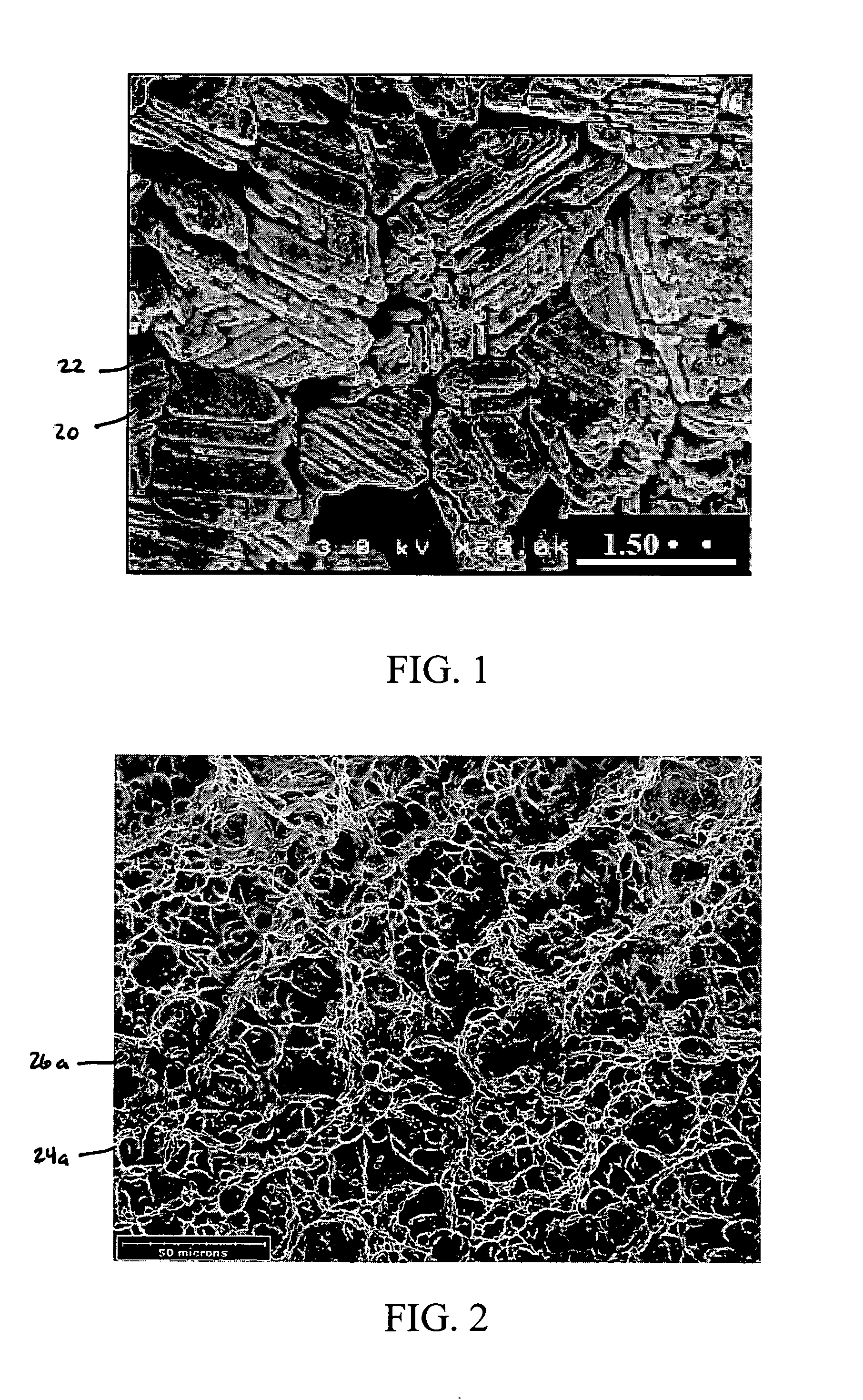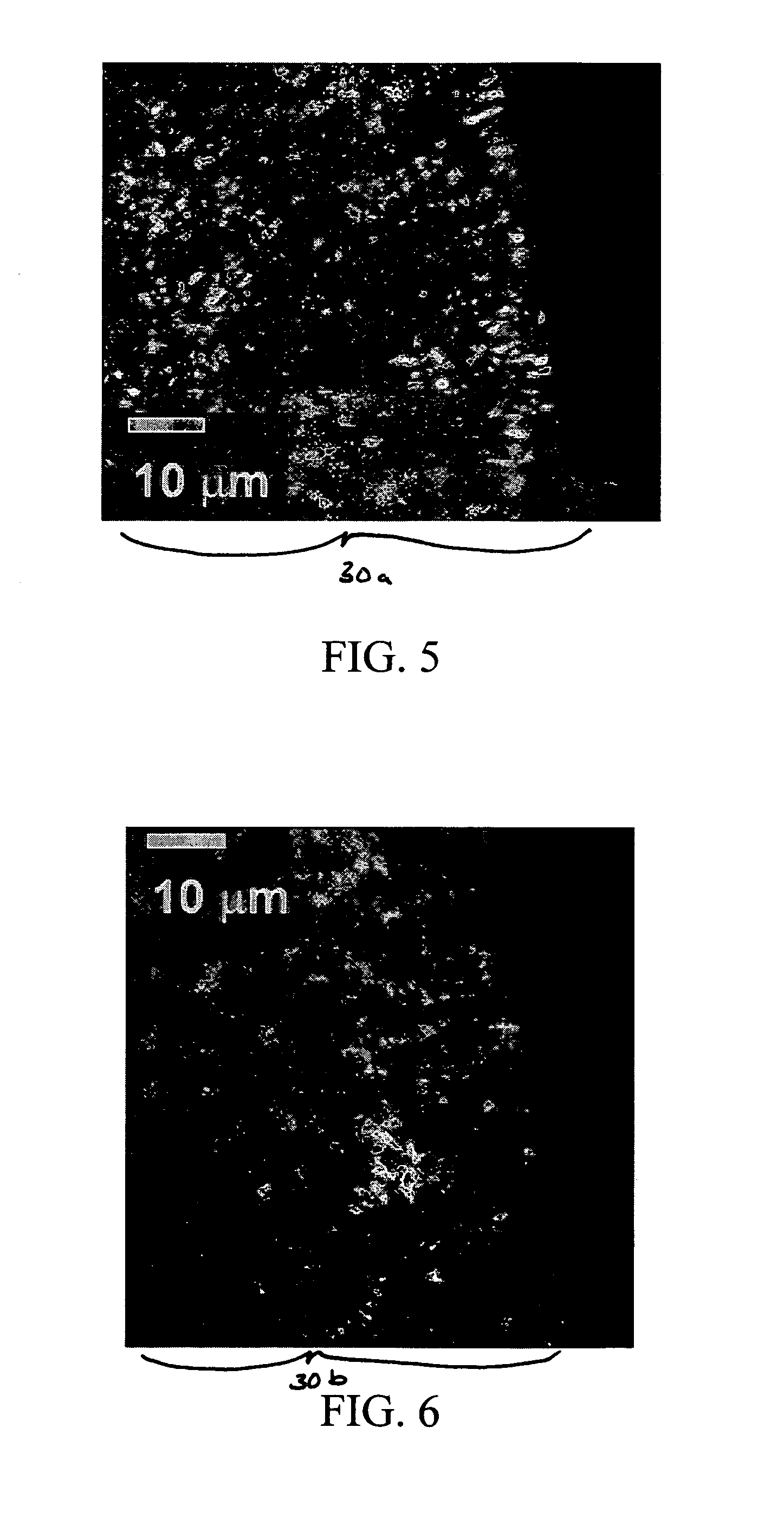Process for diffusing titanium and nitride into a material having a generally compact, granular microstructure and products produced thereby
a technology of titanium and nitride, which is applied in the direction of solid-state diffusion coating, natural mineral layered products, vacuum evaporation coating, etc., can solve the problems of affecting the quality of titanium products, etc., to achieve the effect of improving the properties of titanium
- Summary
- Abstract
- Description
- Claims
- Application Information
AI Technical Summary
Benefits of technology
Problems solved by technology
Method used
Image
Examples
example 1
[0036]FIG. 5 illustrates a base material 30a containing carbide prior to having titanium and nitride diffused therethrough. As shown in this figure, the base material 30a is consistently lighter, thereby showing the granular structure of carbide. The base material is subjected to the present invention process as follows.
[0037] The base material 30a containing carbide is soaked in a moderately heated non-electrolyzed salt bath which contains activated-electrolyzed metallic titanium. Sodium dioxide and a salt selected from the group consisting of sodium cyanate and potassium cyanate is present in the salt bath. Additionally, up to about 20 w / w % of NaCO2 or sodium chloride may further be added. To the bath is added from about 2 to about 20 micrograms of electrolyzed metallic titanium. The base material 30a containing carbide is soaked in the bath for from about 10 minutes to 24 hours at from about 430° C. to about 670° C. The electrolyzed titanium catalyzes the diffusion of the titan...
example 2
[0039]FIG. 7 illustrates a carbide treated with a Chemical Vapor Deposition (CVD) process and prior to having titanium and nitride diffused therethrough in accordance with an aspect of the present invention. As discussed above, conventional nitriding surface treatments are deficient coatings or surface treatments for materials containing carbide. The protective layer formed by these conventional processes, such as a CVD process, generally has a weak adhesion with the carbide surface, thereby causing it to be susceptible to chipping. Moreover, these conventional treatments do not strengthen or increase the tensile properties of the carbide itself.
[0040]FIG. 7 illustrates a protective layer 32c produced by a CVD process. As further illustrated in FIG. 7, there is a distinct interface and demarcation between the protective layer 32c and the carbide surface of the base material 30c, thereby illustrating a relatively weak adhesion therebetween. FIG. 7 further illustrates that the CVD pr...
example 3
[0043] A metal alloy comprising carbide was used as a base material for a turning insert. The base material additionally included vanadium. The turning insert was further treated with a CVD process. This turning insert was treated by soaking in a heated salt bath (NaCNO and about 10 w / w % of NaCO2), for 2 hours at 545° C. in which 2-20 micrograms of electrolyzed metallic titanium was added. The turning insert was then cooled and dried. The insert was then washed to remove an oxidation layer formed as a result of heat being applied thereto during and after the diffusion process.
[0044] The aforementioned turning insert treated with the present invention process was tested and compared to a turning insert treated only with a CVD process under the same operating parameters:
Material MachinedCarbon SteelWork Diameter19″Spindle Speed (SFPM)330 Feed Rate IPR 0.04Depth of Cut0.25″ per sideLength of Cut4′9″No. of Passes8
[0045] After testing, the turning insert treated with the present inv...
PUM
| Property | Measurement | Unit |
|---|---|---|
| Temperature | aaaaa | aaaaa |
| Temperature | aaaaa | aaaaa |
| Temperature | aaaaa | aaaaa |
Abstract
Description
Claims
Application Information
 Login to View More
Login to View More - R&D
- Intellectual Property
- Life Sciences
- Materials
- Tech Scout
- Unparalleled Data Quality
- Higher Quality Content
- 60% Fewer Hallucinations
Browse by: Latest US Patents, China's latest patents, Technical Efficacy Thesaurus, Application Domain, Technology Topic, Popular Technical Reports.
© 2025 PatSnap. All rights reserved.Legal|Privacy policy|Modern Slavery Act Transparency Statement|Sitemap|About US| Contact US: help@patsnap.com



